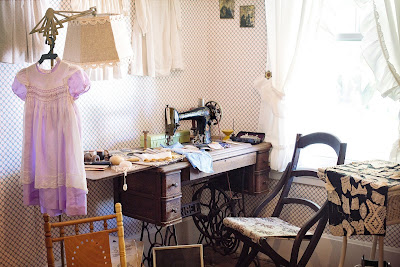 |
| Setting Up a Sewing Room to Increase Your Creativity image courtesy of Pixabay |
How to Set Up a Sewing Room
The size of the room you're working with has a lot of impact on the way you can set it up. However, even tiny rooms (like the adorable sewing nook shown above) can be set up to boost your creativity and to make it easier to find things quickly.
Think About Your Basic Sewing Needs First
You need a place to cut out material, a place to put your sewing machine, and enough room for at least a small ironing board for pressing seams and smoothing out fabric wrinkles. These things can all be space-grabbers, so it's good to make room for them before filling up your available floor space with other things. Another good thing to add to a room that's a bit a larger is a cabinet with doors to store your fabric and materials. The doors help keep dust from settling on your sewing supplies.
Organizing a Sewing Room
Some things to consider including in your sewing room as space allows:- Filing cabinet: for storing patterns and notebooks with notes about your projects
- Dressmaker's dummy: to display garments during the fitting phase and to experiment with when draping fabric
- Open shelving unit: great for stacking smaller boxes of patterns and sewing notions
- Extra directional lighting: to enhance visibility and reduce shadows when you want to sew after dark
- Under-table storage: take advantage of the unused space under your cutting table to store plastic tote bins or cardboard boxes of sewing supplies.
- Wall shelves and hooks: also let you make great use of otherwise wasted space in your sewing room.
Start With an Empty Space
You'll find that starting with an empty room and setting it up around your needs is easier than rearranging a room that's already packed full. If you're setting up your sewing room in the house where you currently live, it may be easiest to remove everything from the room long enough to set it up for your needs.
If you're wanting to find some new digs to move into and set up your sewing room, check out these houses for sale: Indianapolis to get some ideas of what's available in that area, and picture yourself filling your sewing room (in a new home) with the things you need to create beautiful garments, quilts or embroidered items.
Stitching it Right is honored to partner with REDFIN to bring you this post!
Stitching it Right is honored to partner with REDFIN to bring you this post!

